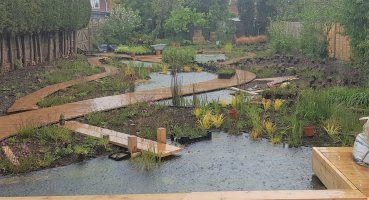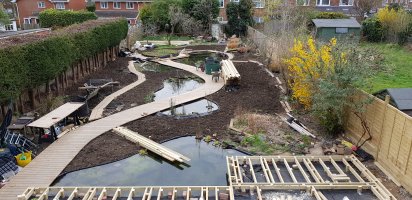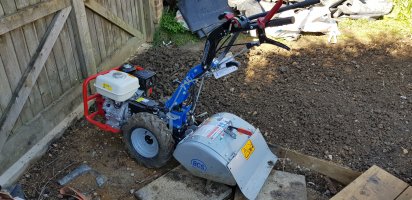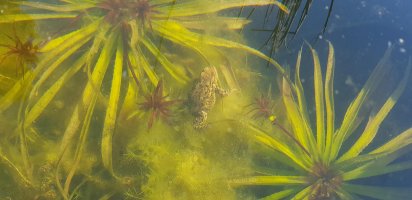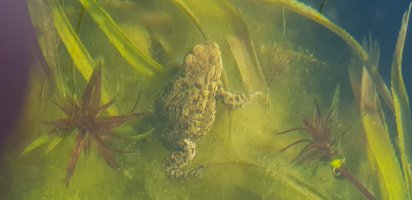Thanks all!
blanket algae that I couldn’t fix until I put in a small 1 litre pot of water cress, after a month the water cress was growing madly and the water was crystal clear
Sounds interesting, I should try some water cress. I still have a lot of thread algae. First I thought I would just leave it, in order to minimise losing newt eggs which would inevitably be included among the Elodea which would come out with the thread algae. I was also too busy preparing the garden for planting and for weeks did not have time for clearing the algae. After a while though, the thread algae was really taking over and I regretted not having taken action sooner. I find that removing it with a garden rake works quite well. I 'comb' the baskets with Elodea and Vallisneria and this way can separate the thread algae from the plants without too many problems. I did lose a huge mass of floating Elodea, which formed a significant proportion of the oxygenating plants in the ponds, but they were totally entangled. There are still hopefully enough baskets left for me to be able to get rid of the free floating oxygenators. I do try to save as much hornwort as I can.


I was hoping for newts but I've never seen one just a crazy amount of frogs every year, always wondered what the newts would need that I didn't have?
I had actually read recently how frogs and newts can have a
boom-bust relationship and bookmarked the articles, so here they are.
"A complex predator-prey relationship between frogs and newts may develop over the years, with their numbers varying". I hear toads in my ponds every evening but so far I have not spotted any mating couples or eggs.
I wanted to make the whole thing a water garden and just have walkways that led from the house to the garage but I was vetoed by the other half and then we had my daughter and then my son and the large-ish pond I had built had to be netted to make it safe for the little ones.
As you say, now your children are getting a bit older, maybe you can start thinking about your water garden again? Could still be dangerous for them for a little while longer though.... There are advantages in doing things bit by bit and expanding your water garden one small pond at a time perhaps?
I was fortunate to have free reign in being able to convert the entire garden. Luckily because of lockdown I have been around to manage the project but trying to do it all in one go has been a bit of a nightmare at times, to be honest. At key stages in the project, a lot of work needed to be done all at once which has been super stressful. Recently, after the builders completed the walkways, the entire garden needed to be prepared for planting which was a lot of work and involved moving hundreds of pots backwards and forwards as I needed to work the soil underneath them. Right now, I am right in the middle of the most exciting phase, and most daunting at the same time - putting in the plants!
There are close to 2000 plants which need to go in, including the 800 I grew from seed last year. After a lot of research, I set myself up with DEFRA as an importer in order to be able to bring in plants from abroad and ordered a large consignment from a Dutch wholesaler which also offered a good selection of aquatic/ marginal plants. A heck of a lot of hassle and a lot more expense because of Brexit (phytosanitary inspection/ import duty/ custom clearing agent's fees) but on the whole it was worth it for me because of the numbers I needed. I also ordered some garden plants from other sources. Neighbours think I have totally lost the plot, which to be honest, I probably have. Hopefully before too long I can actually use my garden to relax in. In the meantime, I have some planting to do. This was taken the day they all arrived;
I had booked in the support of Hayley and Sam from Plantology (who helped me design the garden) for three days to lay out and plant as many as we could in that time. Unfortunately, in the end we only had one day and then our 2021 rain season began. I have not been able to do much planting since. Only a fraction of the plants are laid out/ planted but the results after day one of planting were transformational:
Since then, I have focussed on sorting out the aquatic plants. Out of all the plants, the most exciting species for me to obtain was Potamogeton lucens. In her pond books, Ada Hofman describes this as the most important oxygenating plant and recommends that it should make up 75% of oxygenators in any pond. Not surprising then, that in Holland, this plant is commonly available at garden centres and aquatic retailers. Hofman claims P. lucens produces biochemicals which inhibit the growth of algae (allelopathy). Stems are brittle and in the past I have bought P Lucens from Holland (pre Brexit) with mixed success and only a small proportion took hold after planting. The ones I bought this time don't look like much at the moment. I have left them in their pots for now and hopefully they will start to grow.
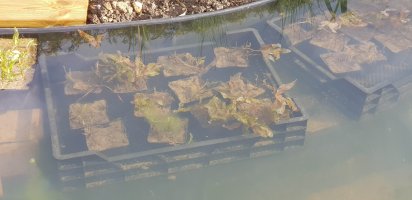

Here is a picture I took of the plant at Ada Hofman's pond gardens a few years ago;

For most marginal plants, I am using 8L pond baskets (24 x 24 x 14cm) lined with weed membrane, with John Innes No3 soil as substrate and capped with sharp sand. With cable ties I made handles so that I can use a rake to move the baskets in and around the ponds. First to be planted up are Persicaria amphibia. I have also ordered Persicaria affinis which I think looks very similar and will be planted in garden soil on the other side of the pond edge later on.


Unfortunately, I did not wash the sand first. I should have known better and as you can see in some of the shots, all that rain we have been having washed out all the dirt from the sand and most of my ponds are now milky coloured. I really hope this will settle eventually.
I am also quite excited that I was able to buy a number of umbellifer flowering type marginal plants. Especially around the pond at the back, the planting in and around the pond will be dominated by umbellifers. Below are Oenanthe aquatica, Oenanthe fistulosa and Sium Latifolium. I also had Peucedanum palustre on the order list but unfortunately that one did not arrive.



Towards the back, where one of the ponds is closest to the row of conifers, I am going to try try create a woodland type planting. I bought a few Marsh ferns, Thelypteris palustris, which I hope will grow nicely in the water. I spent an afternoon playing around with the stump of a conifer tree I dug up last year, and some of its roots, which I had kept for this purpose. It reminded me of moving pieces of redwood around in my planted tank. I think the ferns could look great around the stump.




I also planted up two of tubs (45 / 65L) with Phragmites australis variegatus and placed both in the pond near the house. These were plants I already had growing in tubs, so they were used to growing submerged. I plan to sink the tubs a little deeper later on when they have grown a bit more.

The weather is really frustrating and holding things back but at least I have now found some time to write this update. Hopefully, I will be back soon to write a bit more about the other plants.
